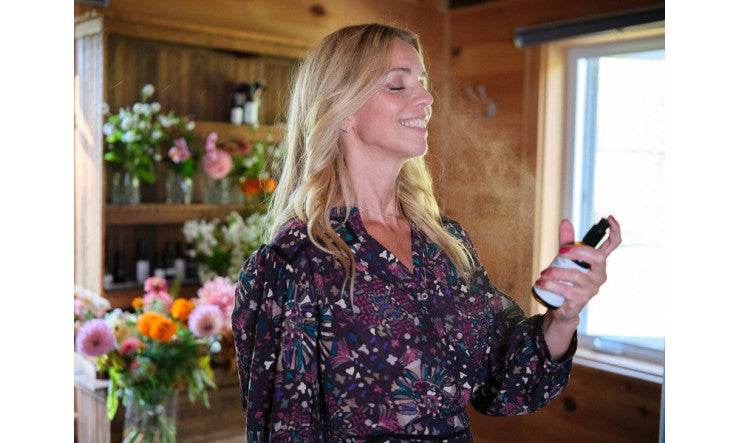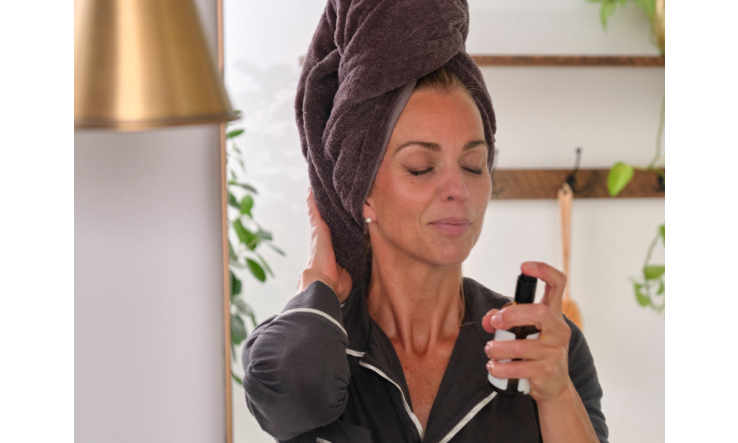A look back at the difference between our formulas (hyaluronic acid & Exfopur) versus injection filling and how our dermabrasion works on wrinkles in the long term.
When applied to the skin, hyaluronic acid will be metabolized but will have already done its job: softening, repairing, and stimulating the remanufacturing of collagen, thus providing cumulative benefits. Thus, the dermis will be stimulated by microcirculation to remetabolize new cells.
Hyaluronic acid injections are fillers, so they stay in the skin; it's like a balloon that you inflate and deflate repeatedly.
For very wrinkled skin, it is worth using the microdermabrasion technique with Exfopur once a week. It is also possible for thin skin, as long as it is able to tolerate it.
Exfopur removes dead cells and acts in 3 forms of exfoliation; mechanical (superficial exfoliation), keratolytic (when left to dry, dead cells will stick to it), aromatherapeutic (cineoles will work as a solvent, which will detach the ceramides). When we refine the epidermis there is a reactive protective effect where it is the dermis that will swell. We will create internal hydration. By creating internal hydration, we will recreate the framework by asking the body to bring proteins that will recreate collagen. The dermis thickens and the epidermis becomes thinner. If the epidermis becomes thinner, wrinkles are less apparent, especially since they are swollen by the dermis which is much more active and younger. We create a reaction by stimulating the dermis to recreate density. The dermis thickens, so the skin is more tightened by the collagen protein and wrinkles are more erased.
ABSORPTION OF COSMERICS INTO THE SKIN. HOW DOES IT WORK?
Excerpt: The incorporation of essential oils in cosmetics, what are the benefits and risks? University of Nantes, Faculty of Pharmacy, Year 2013, No. 021, Thesis for the state diploma of Doctor of Pharmacy, by Thomas Leclair, presented and publicly defended on September 27, 2013.
The skin is made up of 3 overlapping layers: the epidermis, the dermis and the hypodermis.
The stratum corneum consists of around thirty layers of cells filled with keratin. It is the outer layer of the skin that ensures its impermeability and resistance.
- Beneath this is the epidermis, a sort of brick wall, each of which is connected to the others by a lipid cement made up of ceramides. Lipid cement is lipophilic. That is, it allows fatty substances to penetrate the epidermis. The bricks, for their part, are hydrophilic cells. By definition, they appreciate water and all water-soluble molecules.
- The dermis, located beneath the epidermis, is the thickest part of the skin. It mainly contains blood vessels, nerves, collagen fibers (70% of the dermis), which are proteins, elastin fibers, and a gel of proteoglycans (mucopolysaccharides) surrounding the proteins and providing a water reservoir for the skin.
- The hypodermis is located deep within the body and is called subcutaneous tissue. It forms a fatty layer that protects the body from external aggressions.
Cosmetics and skin hydration
Skin and circulatory exchanges are very complex. Here is a summary of what you need to know:
The use of cosmetic products helps increase skin protection and regulate its hydration. By using unbalanced recipes or poorly adapted products, it is easy to disrupt the proper functioning of the skin; either by slowing down exchanges and depriving the external surface of a humidifying factor or a lubricating deposit, or by increasing water penetration and inducing a disruption of the water circulation.
If hydration is insufficient, the skin becomes rough, whitish, scaly, uncomfortable, and unsightly. Conversely, if the skin is overhydrated, it becomes turgid and scaly. It no longer effectively plays its role as a barrier.
Certain factors influence skin absorption: the condition of the skin, the physicochemical characteristics of the active ingredients, but also the type of formulation chosen and in particular the ingredients that compose it. The whole challenge of cosmetics is therefore to slow down transcutaneous water loss (the measurement of the quantity of water from the body that passes into the atmosphere, by diffusion or evaporation processes) and to facilitate the penetration of active ingredients into the skin.
Water or oil for the skin?
The skin does not need to receive a massive amount of oil or conversely water to be hydrated.
Water used alone, when sprayed on the face, does not penetrate the deep layers of the dermis and evaporates quickly. Oil used alone, even if it penetrates the dermis, can cause discomfort in certain skin types (overly greasy effect). It can also clog the skin's pores and prevent the proper evacuation of sebum. Oil is therefore nourishing even if it protects the skin from dehydration.
What to do?
To hydrate the skin long-lastingly, you need to use emulsions. The skin does not absorb water directly. You therefore need to use a mixture of fatty substances and dispersed water, i.e. an emulsion that makes hydration possible through a phenomenon similar to that of capillarity (improved wetting effect). E.g.: Oil plus Floral Water, together.
There are different types of emulsions, and here we'll cover the most common ones. The two most commonly used at home are oil-in-water emulsions and water-in-oil emulsions. The latter protect and hydrate the skin better by forming an occlusive film on the surface.
To optimize the moisturizing effect of cosmetic preparations by focusing on the effectiveness of active ingredients, regardless of the type of emulsion chosen, it is essential to add film-forming, humectant, and emollient agents to the emulsions. They combat the phenomenon of water evaporation. But also, and above all, they capture water from the dermis and retain it inside the epidermal cells.
Film-forming agents
They remain on the surface and do not penetrate the skin. They strengthen the skin's hydrolipidic properties and limit water evaporation. There are two types of film-forming agents.
Hydrophobics reduce water loss by nearly 98%. They have an oily texture and are occlusive and do not allow the skin to breathe, but their effect on the skin is not long-lasting.
This is the case of vegetable waxes (carnauba, candelilla, mimosa, etc.). Hydrophilic waxes are capable of capturing water to form a hydrocolloid, i.e. a hydrogel that forms a film on the skin while allowing it to breathe. This is a supply of superficial hydration. This is the case of complex carbohydrates such as hyaluronic acid and hydrophilic polymers of plant origin such as polysaccharides such as inulin, chitosan, carrageenan.
Emollient agents
These are mainly fatty substances that are made up of lipids and penetrate deep into the epidermis. By filling microfissures, they smooth, soften, and protect the skin's surface. They also combat water evaporation, but are less effective than film-forming agents. Vegetable oils and butters, animal fats, and free lipids (esters, ceramide, fatty acids) are emollients. They are sometimes comedogenic (certain vegetable oils) but have a long-lasting effect.
Humectants
They have hygroscopic abilities, meaning they behave like sponges. Penetrating into the heart of cells (cytoplasm), they attract and retain water. The vast majority of humectants used in cosmetics are naturally present in the skin and constitute NMF. These include glycerin, urea, amino acids, sodium lactate, and simple sugars. Humectants give cosmetics significant moisturizing power with 24-hour effectiveness. They are either hygroscopic themselves (like glycerin) or make epidermal cells more hydrophilic (like urea).
Skin absorption
When a cosmetic is applied to the skin, the water it contains evaporates fairly quickly after application. The evaporation rate depends on humidity and ambient temperature, but also on the skin temperature and the amount of product applied. This phenomenon is not a bad thing, because the penetration rate is proportional to the amount of volatile solvents present in the cosmetic formulation. Thus, the concentration of active ingredients on the skin's surface increases, and their penetration rate is greater.
It is noted that high skin temperature promotes diffusion through the stratum corneum by creating a vasodilation effect. It is also important to know that from the moment a product is applied to the skin, the penetration rate is significant. Even if the exposure is only a few minutes, the active ingredients in the product can penetrate for more than a day.
JACYNTHE HOME CARE
Personalized treatments combining specific application methods according to protocols respecting the laws of skin absorption for optimal effectiveness.
Maison Jacynthe's treatment protocols are designed to optimize skin penetration. They combine:
- Humectant/Emollient Cleansing
- Deep cleansing detoxification/oxygenation
- Triple action exfoliation (keratolytic / fluidifying / oxygenating)
- Decongestation/detoxification/purification/asepsis
- Imbibition/Saturation
- Activation of microcirculation/lymphatic drainage
- Transcutaneous absorption by osmotic/thermal pressure
- Revitalization and oxygenation
- Saturation of cellular nutrition
- Pleasures
The combination of product choice, application protocol and chosen treatment method allows for immediate and long-lasting visible results.
Humectant/Emollient Cleansing:
Is done during surface cleansing and adapts according to skin conditions: Cleansing oil/ Floral water/ Specific gel, etc.
The goal of this step is to soften the corneocytes and begin corneal imbibition. Dead cells eventually absorb some of the applied fluids and, as they swell, lose their cohesion with the underlying cells. The epidermal barrier weakens, allowing for better receptivity to the next steps of the treatment.
Deep cleansing detoxification/oxygenation:
When necessary or for specific treatments against spots or scars, a second cleansing with Cleansing Oil mixed with aromatic formulas such as Exfopro, Dermopur, Claripro.
Triple action exfoliation (keratolytic / fluidifying / oxygenating):
A unique technique that gradually reduces skin imperfections, restoring youth and freshness to the skin.
Note: Never exfoliate before sun exposure.
The expected results are as follows:
- Skin firming
- Reduction of small facial scars
- Reduction of wrinkles and fine lines
- Decreased appearance of dilated ostia
- Decrease in the thickness of the epidermis and increase in the volume of the dermis
- Reduction of acne scars
- Dissolving blackheads
- Reduction of pigment spots
- Removes superficial milia
Decongestation/detoxification/purification/asepsis:
An important step after exfoliation, extraction, and descaling, or for sensitive and reactive skin. Aloe gel, with its calming and refreshing properties, is the base that can be applied as is as a mask or mixed with floral water, essential oil (1 drop and never more) or an aromatic formula.
For dehydrated skin, a gauze soaked in floral water will provide better hydration. For seborrheic skin, the same principle applies. For sensitive skin, it is best to leave the gel exposed to the air to help lower skin temperature.
Imbibition/saturation:
Principle of saturating the skin with moisturizers and nutraceuticals by applying alternating water complexes (floral water), lipid complexes (serum) and colloidal complexes (gel).
Excellent interaction between:
Essential oils & Vegetable oils
Essential oils are lipophilic (attracted to lipids). They form a symbiotic relationship with vegetable oils. They disperse very well in vegetable oil, which not only becomes an excellent support for massages, but also an active ingredient in its own right. The combination of virgin vegetable oils and pure essential oils results in a ready-to-use product and makes it possible to create products intended for a multitude of high-quality treatments.
Excellent assimilation of lipids up to the dermo-epidermal barrier
Vegetable oils are naturally hydrolyzed by skin enzymes. Particularly those that facilitate the reaction of organic molecules like vitamin B. However, vitamin B is found in high concentrations in cold-pressed vegetable oils, which accelerates their absorption rates, carrying the essential oils to the basal layer of the epidermis. A few minutes after the anointing, blood tests show the presence of aromatic molecules in the blood. Fifty minutes to two hours after application, aromatic molecules are present in the exhaled air (ref. Biblio.: Aromatherapy exactly. By Doc. D. Phénoël/page 297 (medicine of interfaces). Once the epidermal barrier is crossed, the essential oils cross the basal membrane to reach the dermis. It is from the dermis that the essential oils will play their main roles. The first being to maintain or restore homeostatic activity (capacity to maintain relative stability of the ambient environment). The second is related to the aromatic components.
Physiological action at the cell level:
Aromatic molecules bathe in the interstitial fluid before being diffused into the circulation to be captured by a protein which will transport them into the cell.
Activation of microcirculation/lymphatic drainage:
It is done by massage or accessories used during therapeutic treatment (suction cup, roller, Gua sha).
Transcutaneous absorption by Osmotic/thermal pressure:
To maximize cellular nutrition, certain application techniques allow for optimal results. Heat is one of the techniques often used to stimulate skin absorption. With a reverse cold application, the action is multiplied, thanks to the capillary vasodilation/vasoconstriction/dynamic gymnastics effect.
Osmotic pressure occurs when the skin is soaked to the point of saturating its epidermal cells with colloidal water (gel + floral water). With the application of a hot thermal mask, over the soaking, intercellular exchange is greatly facilitated and once again allows the absorption of the nutraceutical.
Revitalization and oxygenation:
In the finishing mask, certain essential oils have revitalizing and oxygenating properties capable of tightening the follicular ostia, fixing hydration, and activating cellular respiration.
Saturation of cellular nutrition:
The raw materials used by MJ offer endless possibilities in nutraceutical care.
Indeed, the choice of plant materials, and in particular, butters which have the power to fix the hydration of the superficial layers of the epidermis and to protect it without asphyxiating it, is one of the many examples used to offer the best skin care.
Relaxation & pleasure:
It is through art that man emerges from his reasoning and from experience at the level of perception that creative faculties emerge.
At the end of this inner journey that is the relaxation of the modeling, bodily life, freed from its tensions, disturbances, opens to all directions of space; in a sort of primitive seizure, the body like the cells seem deprived of contours and spread into the environment like an emission of vibratory waves.
PHYSIOLOGY OF SKIN PENETRATION
Excerpt: Transcutaneous penetration of active substances: Application in dermocosmetology, Amandine Georgel, HAL Id: hal-01732837, https://hal.univ-lorraine.fr/hal-01732837 , Submitted on March 14, 2018.
The term "penetration" or "cutaneous permeation" describes the path of a molecule applied to the skin, from its fixation within the stratum corneum to its eventual systemic passage.
Cosmetic substances, by definition, should not penetrate the skin in its entire thickness, this action being reserved for therapeutic products. However, certain active molecules can exceed this limit and end up in the general circulation, hence the importance of knowing the reality and the proportions of this passage.
3.1. Mechanisms and routes of absorption
3.1.1. Kinetics of skin absorption
Transcutaneous absorption is a passive diffusion phenomenon which occurs at the level of each of the layers of the skin (35) and is divided into several stages.
The molecule must first leave its excipient and dissolve in the hydrolipidic film to cross the skin barrier. It penetrates the stratum corneum through the intercellular spaces: this is "penetration".
The distribution of the molecule is done according to a linearly decreasing concentration towards the deepest layers (1). A part remains at this level and constitutes a reservoir. Then it diffuses into the different layers of the epidermis which are completely hydrated and then continues to diffuse into the dermis, which is also hydrophilic (35). The diffusion from one layer to another is called "permeation".
At the dermal level, they come into contact with the capillary vascular system, which is responsible for reabsorbing a portion of them, which then passes into the general circulation to provide a systemic action. This is "resorption".
Diffusion can continue into the hypodermis and even into subcutaneous tissues (35).
Each step is characterized by its own speed and the speed of the overall process will depend mainly on the slowest step.
You might also like to read and discover:
Discover our 4 hyaluronic acids
Care protocol - Skin condition charter



































































Leave a comment